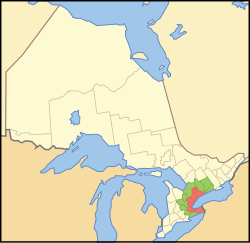Greater Golden Horseshoe
| The Golden Horseshoe | |
|---|---|
| Secondary region | |
 Location of the Golden Horseshoe in Ontario. ██ Core area ██ Extended area |
|
| Coordinates: 43°36′N 79°44′W / 43.6°N 79.73°WCoordinates: 43°36′N 79°44′W / 43.6°N 79.73°W | |
| Country |
|
| Province |
|
| Area | |
| • Total | 31,561.57 km2 (12,185.99 sq mi) |
| • Extended area | 21,464.12 km2 (8,287.34 sq mi) |
| • Core area | 10,097.45 km2 (3,898.65 sq mi) |
| Population (2016) | |
| • Total | 9,245,438 |
| • Density | 277.53/km2 (718.8/sq mi) |
| • Extended area | 1,843,117 |
| • Core area | 7,402,321 |
| Time zone | EST (UTC−5) |
| • Summer (DST) | EDT (UTC−4) |
| Postal code prefixes | K, L, M, N |
| Area code(s) | 226, 249, 289, 365, 416, 437, 519, 647, 705, 905 |
The Golden Horseshoe is a region of Southern Ontario, Canada, which lies at the western end of Lake Ontario with outer boundaries stretching south to Lake Erie and north to Georgian Bay. The region is among the most densely populated and industrialized in Canada. Most of it is also part of the Greater Toronto and Hamilton Area, Quebec City–Windsor Corridor and the Great Lakes Megalopolis. With a population of 9.39 million people in 2016, the Golden Horseshoe makes up over 26% of the population of Canada and contains more than 68% of Ontario's population, making it one of the largest population concentrations in North America. The area has a greater population than the entire province of Quebec or the three Prairie provinces, four Atlantic Provinces, and three northern territories combined. Although it is a geographically named secondary region of Southern Ontario, the Greater Golden Horseshoe is also used today to describe a broader region that stretches from the area of the Trent–Severn Waterway to at least the Grand River area, including centres outside of the core region.
The core of the region starts from Niagara Falls at the eastern end of the Niagara Peninsula and extends west, wrapping around the western end of Lake Ontario at Hamilton and then turning northeast to its anchor city Toronto (on the northwestern shore of Lake Ontario), before finally terminating at Oshawa, just east of Toronto. The wider region spreads inland in all directions away from the Lake Ontario shoreline, southwest to Brantford, west to the Waterloo Region area, north to Barrie, and northeast to Peterborough. The whole region's area covers approximately 33,500 km2 (13,000 sq mi), out of this, 7,300 km2 (2,800 sq mi) or approximately 22% of the area is covered by the environmentally protected Greenbelt.
...
Wikipedia
